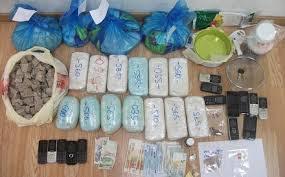by FHS Students
Ms. French’s CWP Class
History of Heroin
During the 1800s, opiates started to be used as a pain killer. In 1811, the drug was named after a Greek god of dreams named Morpheus. The U.S. was exposed to the drug in the late 1860s when Chinese immigrants came to work on the railroad. When heroin was the newest form of opium, it was first produced commercially by Germany’s Bayer Company in 1898. The extremely addictive drug called heroin was legal all over the U.S. until the 1920s.
Opioids come in many forms such as a white or brown powder or black goo, which is called black tar heroin. The drug can be used in many ways such as smoking, injecting and snorting. People use spoons to liquefy the black tar so the users are able to inject it through their veins. People who commonly use the drug start to mix it with water or other drugs to try and get the same high they had when it was the first time they used the drug.
In the 2000s, OxyContin was an opioid that was sold as a miracle drug. It treated severe pain but was highly addictive. The amount of OxyContin sales had grown from $48 million in 1996 to $1.1 billion in 2000 which increased the amount of abuse, addiction and diversion throughout the U.S. People who become hooked on pain pills usually turn to heroin as a secondary drug. This was the beginning of the current epidemic.
Afghanistan
After the attacks on Sept. 11, 2001, the United States entered Afghanistan for war. This war caused the already growing opium trade to skyrocket. Fifteen years later, Afghanistan is still ruling the heroin trade with 90 percent of the world’s heroin coming from poppy fields scattered all over the unstable country. In Afghanistan, the drug trade increased while the war has increased bloodshed and violence.
Ever since the US intervened, they have done almost nothing to stop the trade. There are pictures of US soldiers walking through poppy fields and watching the farmers as they harvest the deadly crop even though the United States dedicated $8.4 billion on counternarcotics. Those efforts completely failed as the heroin trade grew even more. It has become Afghanistan’s cash crop resulting in a profit of almost $3 billion a year.
There are plenty of reasons why the US would not intervene. The heroin that is distributed does not reach the coasts of the United States. It is mostly sent to places like China, Europe, Africa and the Middle East. Afghanistan has dedicated over 500,000 acres of land to grow the poppy. This is a very alarming number because it is more than what Latin America dedicates to coca fields.
Although it is a huge problem, none of the world’s superpowers is doing anything to stop it. They turn a blind eye to it and there are even rumors the CIA and the US government help Afghanistan farmers export it because there is a huge profit to be made. Although they are unconfirmed, it would explain why US soldiers would be walking around them and even protecting these massive poppy fields. Afghanistan is leading the worldwide heroin epidemic and part of it is to blame on the US invasion in 2001. Taliban has control of the other Middle Eastern countries and has very large amounts of weapons, drugs and manpower.
China
China is now believed to be the main transit point for heroin from Myanmar to the United States. In China, opium is made in the Golden Triangle which is in Myanmar. Opium is sent to jungle laboratories to be purified to heroin. It is smuggled in the Yunnan province in China where it is then delivered to Chinese syndicates who ship the heroin to Kunming and then Shanghai, Hong Kong and other coastal cities where they ship them on boats to North America and Europe.
There are estimated 3-7 million addicts in China alone. China and India are believed to have the fastest growing market for opium. In these places, prices are low and total sales are probably less than $10 billion. The Chinese government knows that their country is the second-biggest opium grower in the world, but there is no evidence that they are trying to stop the corporations. Some say that the government officials have been paid to look the other way. The title of greatest opium grower was taken from China to Afghanistan after the 20th century.
The China connection is allowing local drug dealers in North America to mass produce fentanyl in pill form, identical to an off-abused version of the prescription painkiller Oxycontin. Fentanyl is used as a part of anesthesia to help prevent pain after medical procedures. It can be very addicting and much more potent than heroin. It can cause serious mental and physical side effects of Fentanyl abuse like seizures, weakened immune system, delusions and personality changes, coma and death. Between 2005-2007 Fentanyl abuse killed more than 1,000 people in the U.S.
Mexico
The Mexican drug trade is a big problem around the world and in our community. They are the primary source of smuggling into the United States. It has been an issue in our local community for as long as we can remember, but the past 10 years have been a lot worse. The Mexican cartels are providing most of the heroin to the U.S. The cartels are buying opium grown in Colombia and processed in Mexico.
The Drug Enforcement Agency works really hard to stop this illegal activity, but there is too much drug smuggling going on for the DEA to stop it all. There are thousands of pounds of black tar heroin confiscated from the cartels. The cartel makes money off of America’s drug addiction. Mexico does not have an addiction problem, the cartels are merely supplying our demand.
Next time in Part III: Overcoming Heroin and Solutions



